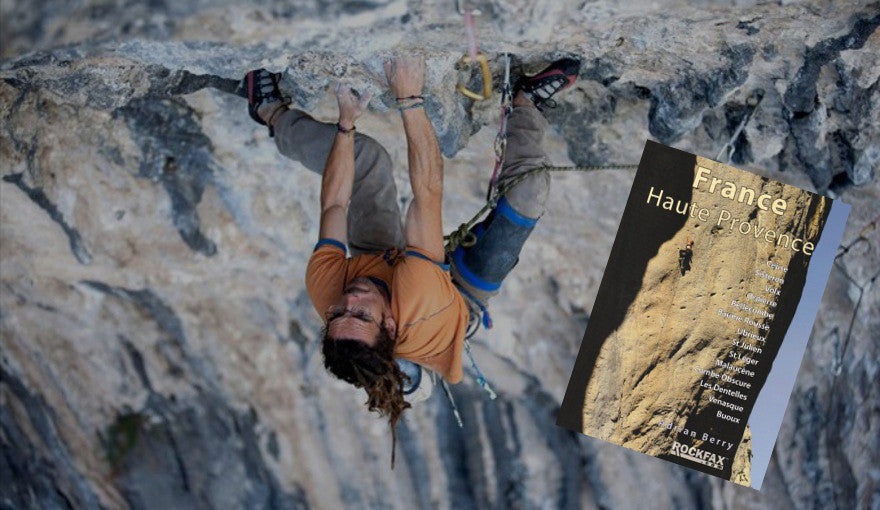By Dave Westlake
With so much stunning climbing in the Provence region, it is of little surprise that most travelling climbers will need to invest in several guidebooks. Well, not any more! With the eagerly awaited publication of this region-wide guide by Adrian Berry, the intrepid Brit can now set off on his or her travels to one of the best sport climbing regions in the world with just a single volume.
Furthermore, this is the only English guide for the majority of areas it covers. Having climbed extensively in the region myself, and spent time in French climbing shops trying to figure out which guides covered which crags, I cannot overstate the difference this new book will make in that regard.
Style and Presentation
The guide is presented in the usual Rockfax style, which will be familiar to many. This is generally a good thing as the action shots are up to the usual high standard and the same can be said for the photo topos. That said, the Rockfax team are not resting on their laurels. This and their other recent offerings are clearly building on years of experience in guidebook production and things really are getting better. Comparing this to my dog eared old “Peak Gritstone East” tome from several years ago reveals that the general production quality has improved dramatically – the photos are sharper and the diagrams easier to follow.
The excellent reference system used across the whole Rockfax series is also in residence here – with shaded tabs on the end of the pages that make finding the relevant section of the book quick and easy. The cover also has a flap which makes bookmarking a doddle – a small but neat feature which I think will be very useful.
Crags Covered
The range of crags that has been included in such a (relatively) lightweight book is impressive, and better still there are 3 or 4 that I’ve never heard of! In total 14 climbing areas are included, ranging from the big and famous (Ceuse, Buoux, St Leger and Orpierre) to the smaller and more reticent (Venasque, Combe Obscure and Bellercombe).
This gives the book a wide appeal as there are many crags that are less well known among its largely British audience, and these have a more extensive range of lower grade routes than places like Ceuse and Buoux.
The crags are organised geographically, starting with “Eastern Crags” and this format is both logical and easy to navigate if you are familiar with the region.
Controversy and Environmental Impact
There is an important debate about the ethics of foreign publishers (in this case Rockfax) profiting from guidebooks to areas that have been developed by local climbers. The argument is that it isn’t fair for the publisher to benefit from the hard work, time and money that locals have invested by developing areas, negotiating access and placing bolts.
Without wishing to enter this debate here, it is worthwhile to point out in the publishers’ defence that an effort has been made to direct us towards the more comprehensive local guides that are available. This is commendable and provides a great resource for anyone planning to spend more time at one particular spot. Web links are also provided where applicable, directing you to sites containing more information, including several accommodation options.
Another hot topic in more than just climbing circles is the environment and the impact that our holidays have on CO2. A great little addition to this guide is the inclusion of detailed info about public transport options – namely the TGV train service. The overview map includes a symbol for train stations and this makes planning an eco-trip a much easier affair.
There is also plenty of information on the logistics of getting around the region without a car and the best places to go if, like many, you are travelling alone and need people to climb with.
The author’s commitment to environmental concerns is further highlighted in the introduction. Berry explains one of the reasons for publishing a guide to the area was because it is easily accessible from the UK by means other than flying.
Conclusion
In brief, this is a superb guide that contains all the knowledge and advice anyone planning a trip to the region. It has an impressive range of areas covered, including the really famous crags and the lesser known gems. There is ample information for the planning of your trip and the guide also does a great job of signposting you on to find more detailed information. The pictures and diagrams are first rate and the book is very easy to use. The only slight disappointment to some may be the lack of history or first ascent information. However, anyone looking for this is sure to consult the more detailed local guides that are mentioned within.
Rockfax guides are clearly improving on their extensive back catalogue in much the same way that the other major publishers are. All this makes for a very good looking and easy to use picture for the world of climbing guidebooks. In the past you may have just bought guides for places you were definitely going to visit, whereas now you might consider buying the guide for inspiration. France: Haute Provence certainly does that with aplomb.















